Abundance is a new book with an old (and wrong) narrative
by JChaoLive
If Democrats want to win, they can't repeat old mistakes.
A good start: challenge the narrative that they lost the working-class.
A bad one: following Abundance
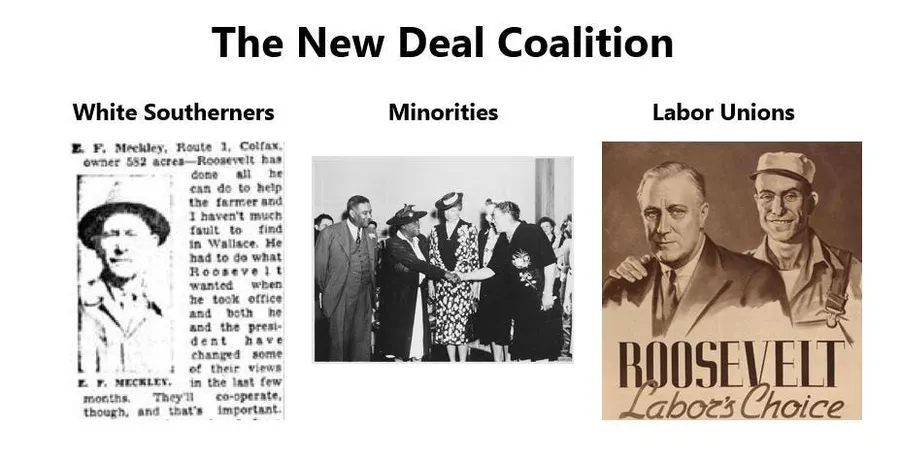
The same old, same old
I hate narratives. They’re almost always wrong. Simplicity has consequences. Yet, they’re compelling and persuasive. That’s what makes them essential in politics. Like reading a story, people follow narratives. But that also makes them a liability. Once a narrative takes hold, it feels impossible to break. To challenge it is to challenge an entire worldview. And bad narratives can lead people to believe in problems that don’t exist—and toward solutions that don’t work.
One narrative on loop since the reelection of Donald Trump is that the Democratic Party has a working-class problem. The sharp rightward shifts among vulnerable demographics have convinced many that Democrats have lost the working-class vote. That’s especially vexing for us Democrats, because our party has long seen itself as representing the working-class. Saying “Democrats lost the working class” not only pins the blame on us—it cuts deep into the party’s identity and purpose. That’s not fun.
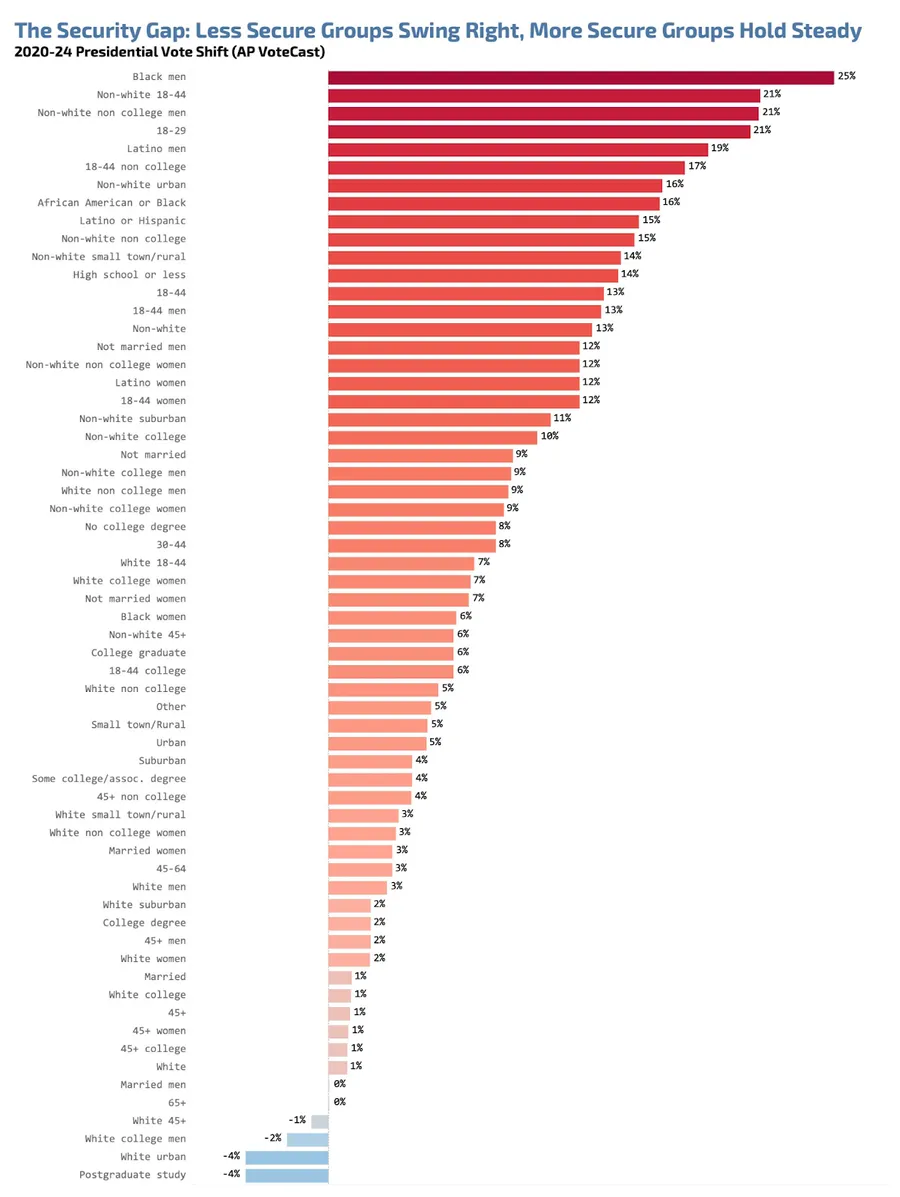
Fueling this narrative is a Financial Times article featuring a chart that tracks why people say they like the Democratic Party. Although the article credits Trump for breaking the “Democrats’ Thermostat,” the long-term trend shows otherwise. The decline in people associating the party with the working-class isn’t as recent as Trump. The narrative isn’t new. It’s existed for decades. In fact, the chart points us straight to another well-worn narrative: that the white working-class abandoned the Democratic Party when it embraced civil rights. Sound familiar?
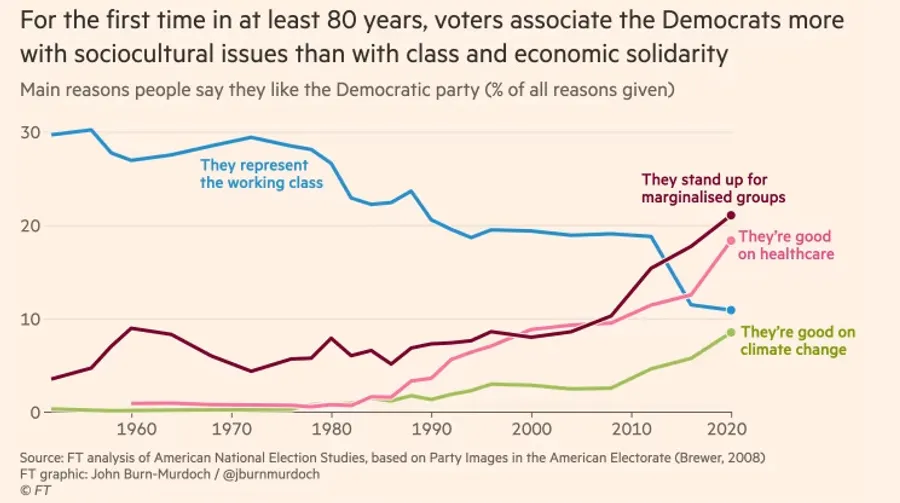
Enter Abundance and its narrative.
Democrats cannot simultaneously claim to be the party of middle-class families while presiding over the parts of the country that they are leaving.
Its author, Ezra Klein, echoes this idea.
Sure, there’s a bit of a switcheroo between “middle-class” and “working families,” but the implication is the same—and so is the argument. Abundance is offering yet another rendition of the same old story.
That matters. One of the book’s foundational claims rests on a narrative that isn’t just oversimplified—it’s become dogma. Klein himself reinforced it in his book, Why We Are Polarized.
America’s political polarization has its roots in the civil rights era, in the Democratic Party choosing to embrace racial equality and the Republican Party providing a home to white backlash.
That’s the dominant story. And it’s the one Abundance continues to tell—and it’s wrong.
Is it here in this room?
There’s a lot to unpack about the 2024 election, but saying Democrats lost the working class isn’t one of them. A look at the voting data tells a different story. If we define the working-class as lower-income voters, then the vote distribution by income suggests the Democratic Party hasn't lost them. The numbers are virtually even! So no—it’s a major overstatement to claim that Democrats have lost the working class.

Similarly, the older version of the narrative doesn’t hold up under scrutiny. Political scientist Jeffrey Stonecash found that the supposed loss of the white working class after the Civil Rights era doesn’t match reality. The evidence suggests that white working-class support for the Democrats was declining well before civil rights became a salient political issue. Intriguing.
Stonecash’s analysis also reveals something striking: the narrative has historically overstated white working-class support for Democrats. In fact, the data shows that Democratic Party ID among white working-class voters was consistently higher than their actual support for Democratic candidates. The reverse was true for Republicans—their support from white working-class voters consistently outpaced formal party ID.
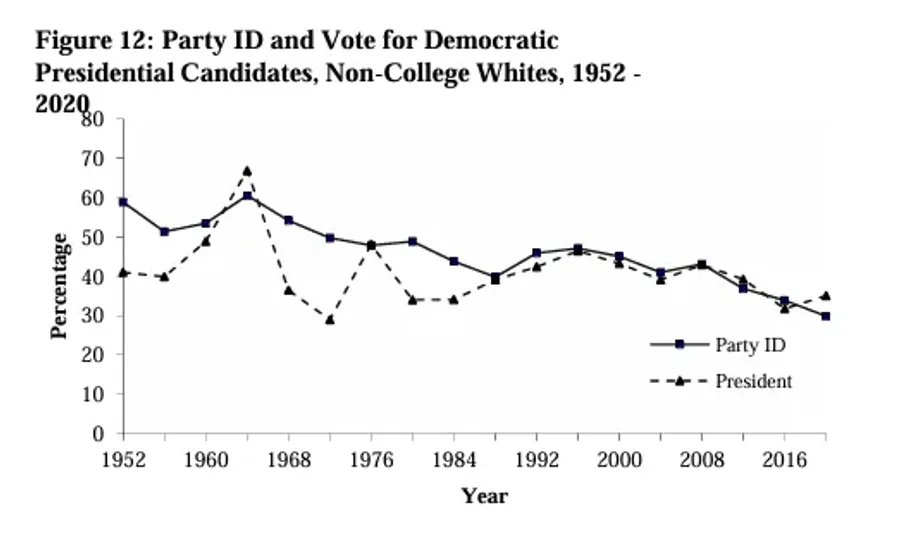
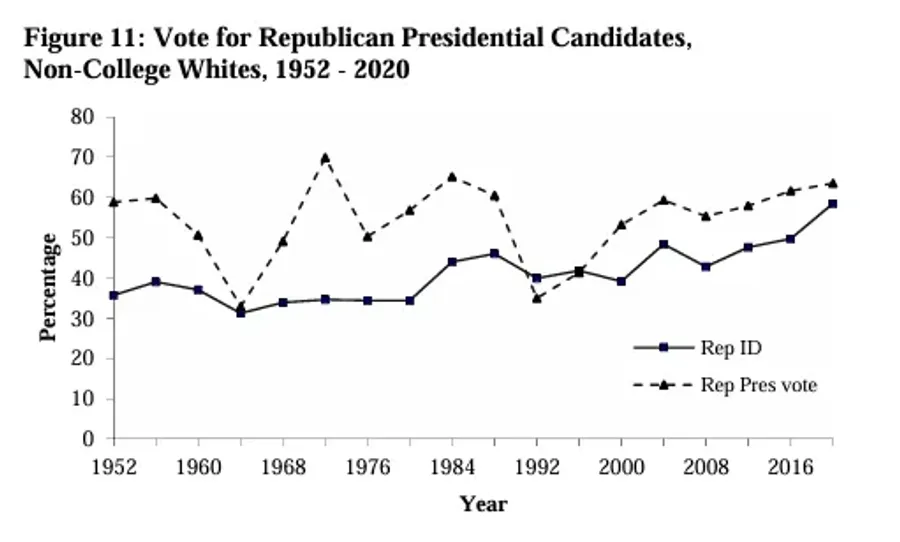
Here’s what may be closer to the truth: Democrats didn’t “lose” the working-class. Democrats never had the working-class. We may need an update. But that won’t come from Abundance, because it continues the same narrative.
The previous discussion already challenges Klein’s aforementioned statement—but Abundance adds its own twists. It argues that blue America isn’t just losing the working-class vote (not true)—it’s literally losing working-class people. Young families are fleeing to red America. And fast approaching is an electoral college map that doesn’t favor Democrats.
Alarming.
But just like the lost working-class narrative before it, the warnings of Abundance are more manufactured than real.
Data from Statista shows that people leaving blue states aren’t overwhelmingly moving to red states. In both 2005 and 2022, movers from blue states split roughly evenly between other blue states and red ones.
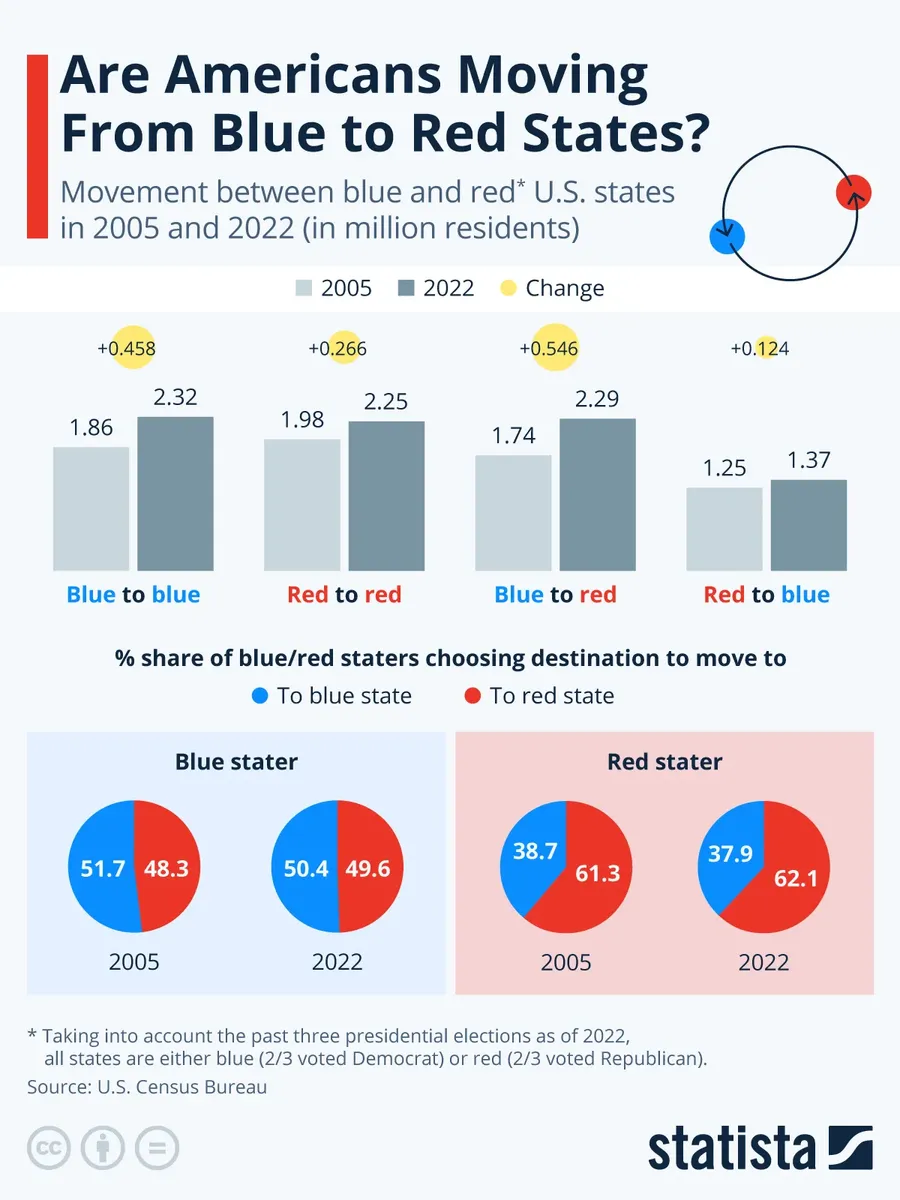
News flash: there are more blue states than just New York and California. But Abundance has tunnel vision on high-profile coastal metros. Something something missing the forest for the trees.
Broader demographic trends tell a different story about the supposed decline in the youth population. Most counties across the U.S. are seeing drops in the number of young children. It’s national. In fact, the only type of county that has seen an increase in young children are exurban ones. The story here isn’t a partisan migration—it’s a fertility crisis, and families who are having kids are seeking more space.
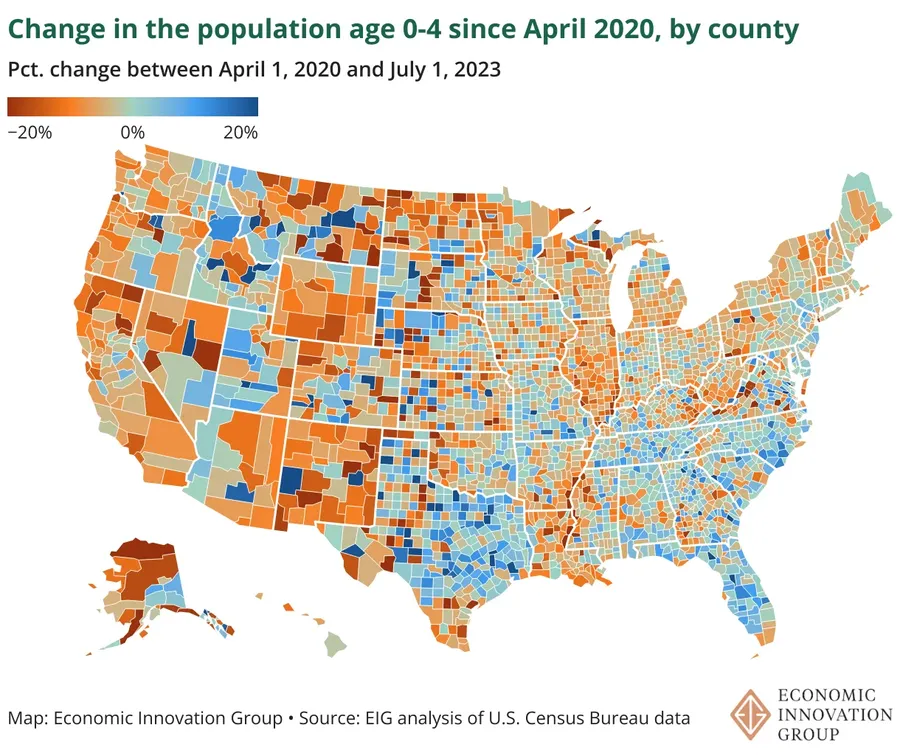
But if we insist on viewing this through a partisan lens, the data doesn’t support Abundance. When comparing the map above with a map of red/blue counties from the 2024 election, ChatGPT found “a general correlation where Democratic-voting counties are more likely to have seen growth or stability in the 0-4 population, while Republican-voting counties more often saw declines.”
It’s worth noting how Abundance plays fast-and-loose with its framing across states, cities, and districts. There are plenty of blue dots in red states—important context for partisan comparisons. But that’s absent in Abundance, which is convenient for its narrative of liberal failure, but incredibly dishonest. Something something missing the trees for the forest … and cherry picking.
Even the grim trends panicking Abundance appear to be reversing. According to new data, the decline of the youth population in cities has significantly slowed. Between 2023 and 2024, the 0-4 population in New York County declined by just -0.05%. In Los Angeles County, it dropped -1.0%. San Francisco County even grew by 0.6%.
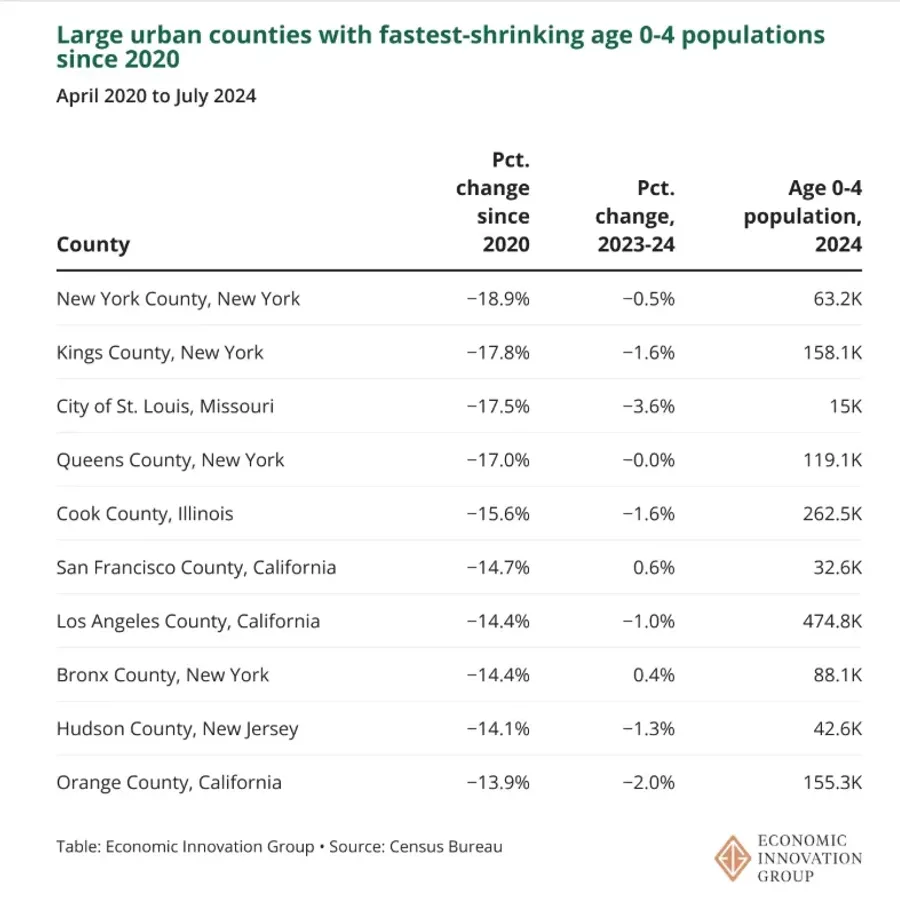
Yes, many cities are far from pre-pandemic levels, but let’s not forget: demographic change isn’t static. Migration patterns, birth rates, etc—they change with time. A lot could happen in a few years. People move. That’s not a crisis.
Also, there was a freaking pandemic! People were escaping density. They’re not going to have kids. Somehow, Abundance wants to believe those are signs of Democrats losing the working-class. Again, convenient for its narrative—but not honest.
Still, Abundance raises a valid concern about the Electoral College. Projections show that blue strongholds like California and New York will lose seats, while red ones like Texas and Florida will gain.
Yikes.
Personally, I’d argue for doing away with the Electoral College—but that may be more ideal than real.
I’m also not the type to advocate for demographic warfare. It feels weird to argue that people should move somewhere for political reasons. That’s a deeply personal decision! But if I have anything to say, it’s this: high density has been a political liability for Democrats. Having most of our base packed into a few small areas doesn’t help us win more Senate seats.
A key component of Republican power has been their dominance of local and state elections in rural areas—a dynamic made possible, in part, because Democrats are so concentrated in cities. My preferred solutions are structural: proportional representation and multi-member districts. But again, that’s more ideal than real.
I don’t think there’s much of a solution to the electoral college, but a friendly reminder: electoral outcomes aren’t fixed. I’m not someone who places hope in a “blue Texas,” but history reminds us—California was once a red state.
Ultimately, the copy-and-paste narrative Abundance offers tells the wrong story. That may not seem like a big deal—but it is. Narratives have a purpose. For Abundance, the story of Democrats losing the working class, blue states losing young families, and an ominous electoral map brings urgency to its core message: that government sclerosis and liberal failure demand a radical shift.
California has spent decades trying and failing to build high-speed rail. It has the worst homelessness problem in the country. It has the worst housing affordability problem in the country. It trails only Hawaii and Massachusetts in its cost of living. As a result, it is losing hundreds of thousands of people every year to Texas and Arizona. What has gone wrong?
Don’t get me wrong—homelessness and housing affordability are very real and very urgent. And high-speed rail? That’s dank as hell. Sooner rather than later, please!
But it’s paramount to get the story right. Abundance doesn’t. It manipulates facts and manufactures panic to push its ideas. Maybe those ideas are good. Maybe they’re even right. But if the narrative Abundance uses isn’t real, can we trust it to point us in the right direction?
I don’t.
Backwards, not forwards
For decades, the dominance of a narrative about the working-class has distorted how Democrats understand their electoral losses. Adolph Reed articulates it clearly.
That orthodoxy tells us to blame ourselves—to say we weren’t good enough, that we failed to meet the expectations of the working-class—as if that alone explains why the working-class doesn't fully support the party that represents it.
It doesn’t. For one, there was an ideological realignment.
Between the Nixon-Ford era and the Trump era, the percentage of working class whites identifying as conservative grew from 26% to 41%. Meanwhile, as the data … show[s], the percentage of conservatives identifying with the Republican Party grew from less than 60% to over 90%.
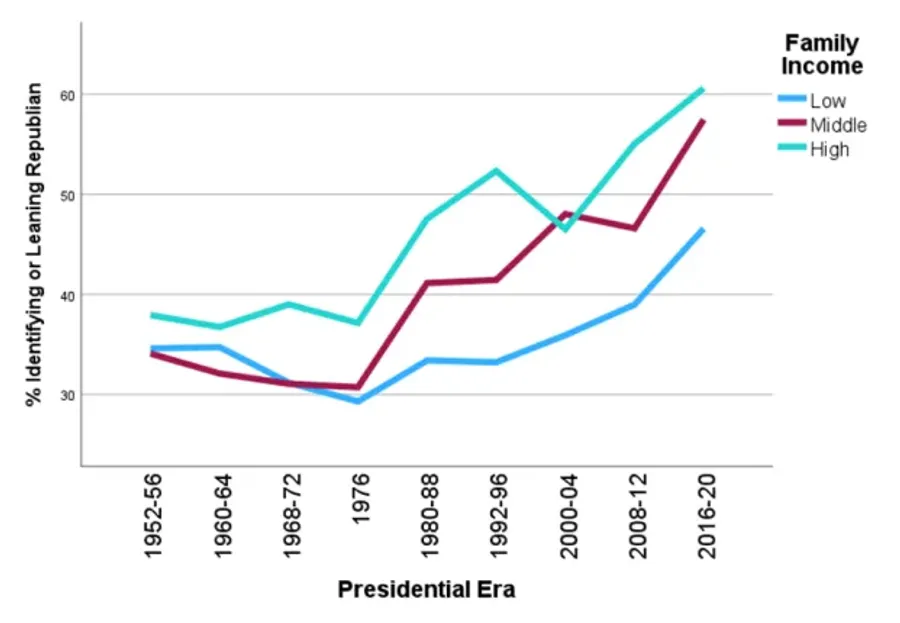
So yes—even though Democrats are the party of the working-class, many working-class voters won’t support them. Because they’re conservative.
The narrative that “Democrats lost the working-class” tells the wrong story—and its consequences run deep.
It’s shaped what we see—and what we miss.
It’s distorted how we understand what motivates the working class.
Most of all, it has disillusioned us into believing we are not who we are.
That narrative is the monster under the bed—it doesn’t exist, but we’ve convinced ourselves it does. And like a trauma-bond, we keep returning to it. It’s wrong—and worse, harmful.
It's long past time to let it go. That’s why we can’t afford to follow Abundance. It tells the same old story that has blindsided Democrats. If we want to succeed, it won’t be with Abundance.
Because it’s looking backwards—not forwards.